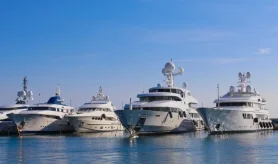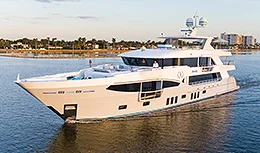- Alaskan Yachts
- Azimut Yachts
- Back Cove Yachts
- Beneteau Yachts
- Benetti Superyachts
- Bertram Yachts
- Boston Whaler
- Broward Yachts
- Buddy Davis Sportfish
- Burger Yachts
- Cabo Yachts
- Catamarans
- Carver Motoryachts
- Center Console
- Chris-Craft Yachts
- Cruisers Yachts
- DeFever Trawlers
- Dufour Sailboats
- Fairline Yachts
- Feadship Yachts
- Ferretti Yachts
- Filippetti Yachts
- Formula Yachts
- Fountaine Pajot Cats
- Grady-White
- Grand Banks Trawlers
- Hargrave Yachts
- Hatteras Yachts
- Hinckley Picnic Boats
- Horizon Yachts
- Hydra-Sports
- Intrepid Boats
- Jarrett Bay Sportfish
- Jeanneau Yachts
- Kadey-Krogen Trawlers
- Lazzara Yachts
- Lekker Boats
- Luhrs Sportfish
- Marlow Yachts
- Maritimo Yachts
- Marquis Yachts
- Mazu Yachts
- McKinna Motoryachts
- Meridian Yachts
- Midnight Express
- MJM Yachts
- Mochi Craft
- Neptunus Motoryachts
- Nordhavn Trawlers
- Nordic Tugs
- Numarine Yachts
- Ocean Alexander Yachts
- Ocean King
- Offshore Yachts
- Outer Reef
- Oyster Sailing Yachts
- Pacific Mariner Yachts
- Palmer Johnson Yachts
April 27, 2011 8:52 pm
Some boats stand out because of their dramatic lines. Others deliver shine due to outstanding workmanship. Some, however, are special because they blend a group of very good qualities into a whole that is greater than its parts. The Dufour 375 is one such synergistic boat.
ON DECK: The cockpit and deck layout of the Dufour 375 say “European” in the clearest terms. Designer Umberto Felci has optimized the boat for the sort of cruising and occasional racing that is popular along the Mediterranean coasts of France, Spain and Italy. These features translate nicely to much of the sailing we do here in North America.
A transom door drops to create an easy path aboard from a dock, the water or a dinghy. Dual wheels open the way for moving straight forward through the cockpit. The sturdy table will seat a crowd and provides a perfect bracing point for the crew when under sail, if you often anchor out with guests of children, you will like this arrangement.
The Dufour’s low, nearly flat cabin top is a Felci specialty and allows easy movement about the deck. Visibility is excellent and there’s lots of space to sprawl out and relax. At the bow, a nicely engineered removable bowsprit locks into fittings to make deploying an asymmetrical spinnaker easy.
The full-batten mainsail drops into a storage bag on the doom at a convenient height. All the fittings are of high quality, nearly installed.
ACCOMMODATIONS: Step through the companionway and you’re in another distinctly European space. The saloon is bright and simple, with plenty of storage lockers all about. The galley occupies the entire starboard side and has two features that serious cooks should love: vast counter space and the biggest fridge I’ve seen on any boat under 50 feet. You won’t want to prepare meals here in a seaway because it is so open, but when you’re stationary, it’s unbeatable.
Not that the saloon is unfriendly in rough water; quite the contrary. There are grabrails concealed into the overhead throughout, and I found them easy to reach even though the headroom is generous. Dufour has a long history of quality construction, so this boat should be quite capable offshore.
Move anywhere in the boat and you find still more lockers. The chart table is sized for a chart book and has stoward beneath both it and the seat. The area under the forward berth is large and easy to reach. If you like to have everything hidden in compartments rather than exposed, Dufour provides the spaces to stash things in.
Like the rest of the interior, the head compartment is bright, simple and functional. The molded fiberglass liner incorporates a shower and a medicine cabinet. The head pumps upward into the holding tank, a system I like better than the more common low-mounted tank that must be pumped to empty it. You’ll never have a problem draining this one at sea, as gravity will not fail.
The forward sleeping cabin has an offset double berth that is easy to get into, while the aft cabins have the conventional small dressing area followed by a double berth shaft. I sailed the model with double cabins aft. The alternate arrangement substitutes a large stowage area for the portside cabin.
There are removable panels for the engine compartment in the aft cabins to supplement the main access point underneath the companionway steps. There should be no problems reaching all parts of the powerplant for maintenance. The batteries are mounted rather high in the engine compartment, and there’s no dedicated space for more than the standard installation.
The interior joinery is of Moabi, a mahogany-like tree also known as African pearwood, and it’s beautiful color and grain certainly enhance the appearance of the cabins. Subdued fabrics and the white of the injection-molded overhead combine to create a pleasant, relaxing environment.
UNDER SAIL: The Chesapeake was in a gentle mood furring our test sail, with winds of only 6 knots at the mouth of the Severn River. But the Dufour 375 didn’t mind a bit, delivering a steady pace of slightly over half the wind velocity and tacking reliably through 85 degrees. Off the wind, it also moved well. That’s a respectable performance for a newly rigged boat of this size and type. We didn’t have an asymmetrical spinnaker to set on the clever spirit, which would have improved our offwind performance dramatically. Although the 375’s sail area-displacement ratio is modest, the combination of an efficient hull and the ability to set extra fabric up front makes the boat a nice performer.
The dual helm stations turned out to be very handy under sail, providing comfortable places to sit or stand and outstanding visibility on either tack. Winch locations were equally handy. I could trim the jib sheets easily from the helm.
UNDER POWER: Motoring was quiet and efficient with the two-bladed fixed prop. I set the Yanmar diesel at 3,200 rpm for a fast cruise, and the boat returned a comfortable 7 knots with a low 72 dBA hum. Conversation at that sound level is easy, and long days motoring will not be tiring.
All the usual maneuvers were easy to perform, as the helm is quite responsive. The 375 turns in a circle of slightly over one boatlength, stops promptly when reversed and backs straight with no undue kick from the rudder. It will be simple to dock or pick up a mooring with this boat.
CONCLUSION: The Dufour 375 is a pleasant step up from the usual production boat. The design is a bit classier, the rig a bit more refined and the accommodations a bit more detailed than slightly less expensive vessels. The combined effect of these little niceties is a clear upgrade in lifestyle that discriminating sailors will notice.










